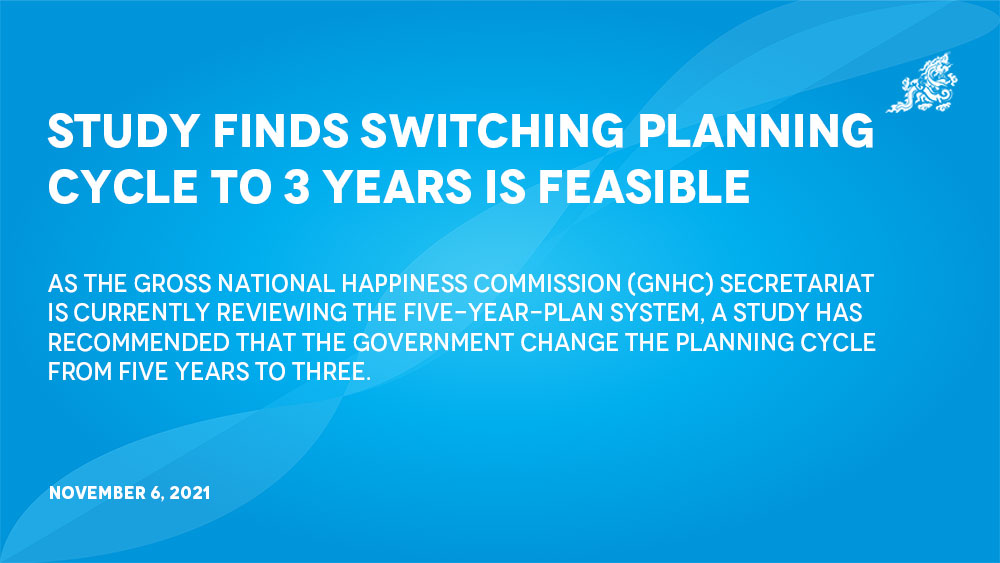As the Gross National Happiness Commission (GNHC) Secretariat is currently reviewing the five-year-plan system, a study has recommended that the government change the planning cycle from five years to three.
The study, conducted by a group of civil servants based at the Centre for Bhutan Studies, found it was feasible to shorten the planning cycle to three years.
The study, which was released yesterday at the Centre, claimed that despite the common perception that donor projects and government-funded activities must begin and end within the five-year-plan cycle, it was proven otherwise. “On the contrary, projects and activities have their own life cycle of varying durations.”
Having studied budget and expenditure data for all the projects implemented in the 11th and 12th Five-Year Plans (FYP) to verify the actual duration of implementation of projects, the study revealed that the average implementation duration of plans was around 2.6 years, which is why the study concluded that a three-year-planning cycle could replace the decades-old five-year-planning system.
The data revealed that the major chunk of donor projects (77.4 percent of projects for 11th FYP and 91.8 percent of 12th FYP) had implementation durations of less than three years.
“The three-year planning system will also provide flexibility for the government of the day to quickly integrate its development manifesto into annual plans and budgets,” the research found.
Today, there are 49 bilateral and multilateral development partners supporting Bhutan’s development activities through various projects. In the 12th FYP, grants constitute about 20 percent of total expenditure and about 55 percent of capital expenditure.
The study also found that switching to a three-year planning cycle would not change much, as all donor projects’ duration ranges from one to several years within and across FYPs.
“Instead, donor partners’ strategies would accordingly adjust with Bhutan’s plan period duration,” the study found.
In the 12th FYP, a total of 1,311 donor projects were implemented; more than 40 percent of the projects were implemented in one to two years.
However, the study stated that a three-year planning cycle would require a rigorous planning and efficient manpower to strengthen the policy and planning division of GNHC, including local governments.
Alignment of election cycle and plan cycle
One of the key reasons for the need to review plans was the mismatch between the planning and election cycle, where the five-year plan is prepared by the government of the day but is endorsed and implemented by the incoming government.
The study also found that five-year plans did not align with the election cycle because of the vacuum created during the interim government and that to align with the plan and government’s tenure, the plan must move forward by three months.
According to the study, a two-year plan cycle could also be an alternative, as future governments can implement one full plan.
“With this, the commencement of the two-year plan wouldn’t have to be moved forward to align with an incoming government’s term,” the study stated. “Making changes to plans would be relatively smooth with a two-year plan system because the time gap between one plan and the next would be shorter.”
It also claims budget forecasts for plans would be relatively more accurate.
However, if a three-year plan cycle is adopted, the possibility to complete most of the projects within the plan period is higher, the study stated.
Meanwhile, the study recommended a separate institutional set up for spatial planning to respond to the evolving and inclusive planning landscape in the country. “There is a need to strengthen the current spatial planning system with the development of spatial plans at all levels, including at the local government level.”
The study found that there was a requirement for ramifications suited to the developmental needs of the modern world and bring balanced regional development.
“There is a need for extensive awareness on spatial planning for planners, especially at the local government level to have maximum participation and input from them. This would lead to inclusive and comprehensive planning,” the report stated.
The Works and Human Settlement Ministry has drafted a Spatial Planning Bill which is expected to be tabled in the winter session of Parliament.
Contributed by
Yangchen C Rinzin,
Kuensel Research Fellow
Centre for Bhutan and GNH Studies.


